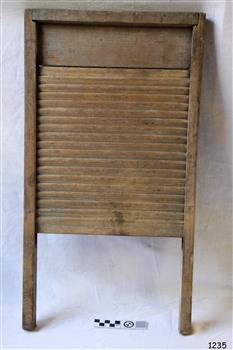Historical information
A washboard is designed for hand washing clothing soaked in hot, soapy water in a wash tub or sink. The fabric is squeezed and rubbed against the ridged surface of the washboard to force the cleaning fluid through the cloth to carry away dirt. With the invention of mechanised cleaning, which became more common with washing machines by the end of the 20th century, the washboard became redundant. The traditional washboard is constructed with a rectangular wooden frame around a series of ridges or corrugations; for 19th-century washboards, the ridges were often of wood, sometimes glass, and by the 20th century, ridges of metal became common. In 1833, Stephen Rust obtained a United States patent for the first "fluted" metal washboard. Zinc washboards were predominantly manufactured in the United States from the middle of the 19th century.
Significance
The washboard is a significant item used for cleaning clothes. It is the forerunner of labour-saving mechanical and electrical laundry equipment. It is still in use today in many countries and helps to understand the domestic life in the 19th and early 20th centuries.
Physical description
Washboard: wooden rectangular frame with two legs and central wooden grid.
Subjects
- flagstaff hill,
- flagstaff hill maritime museum and village,
- warrnambool,
- maritime museum,
- maritime village,
- great ocean road,
- shipwreck coast,
- washboard,
- laundry,
- clothes washing,
- clothes cleaning,
- washing,
- household item,
- washing equipment,
- laundering equipment,
- laundering,
- domestic laundry,
- scrub board,
- 19th century washing appliance
References
- Wikipedia History of the washboard

